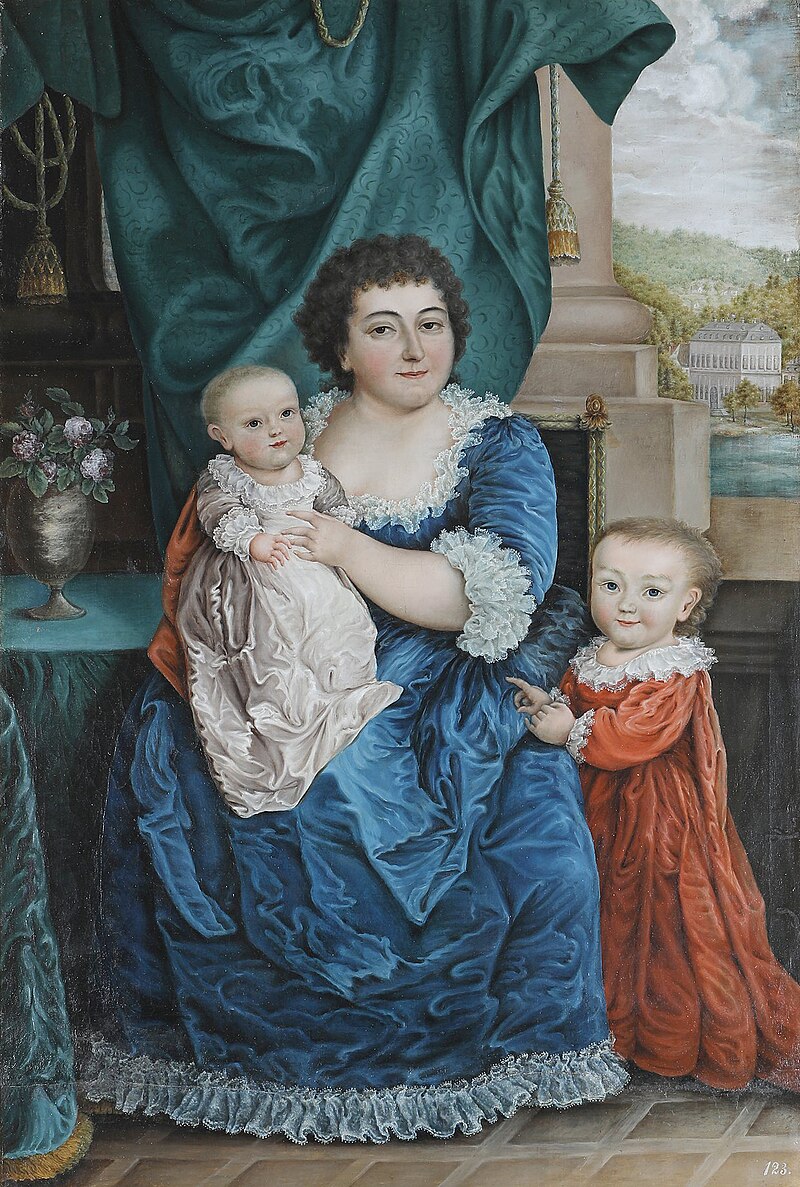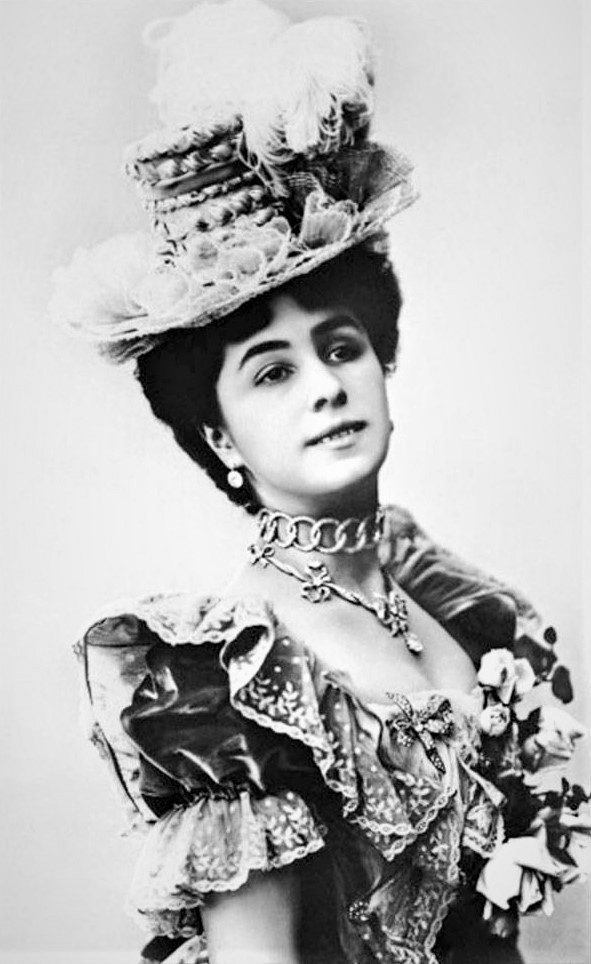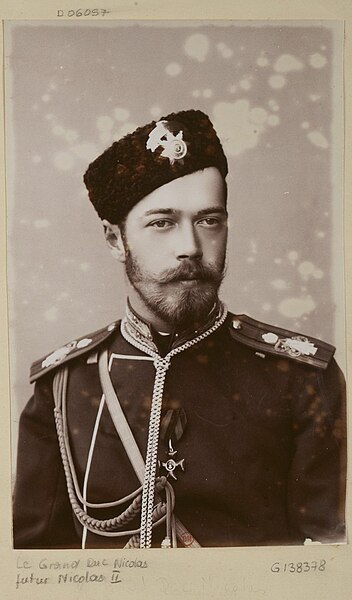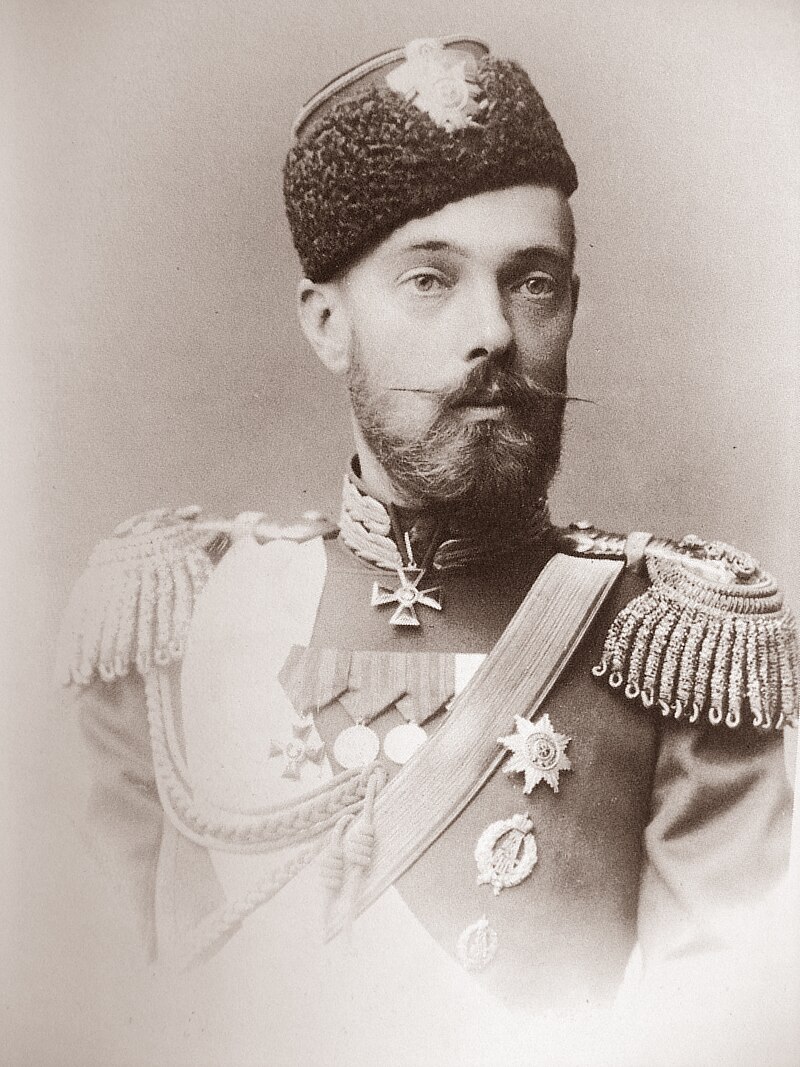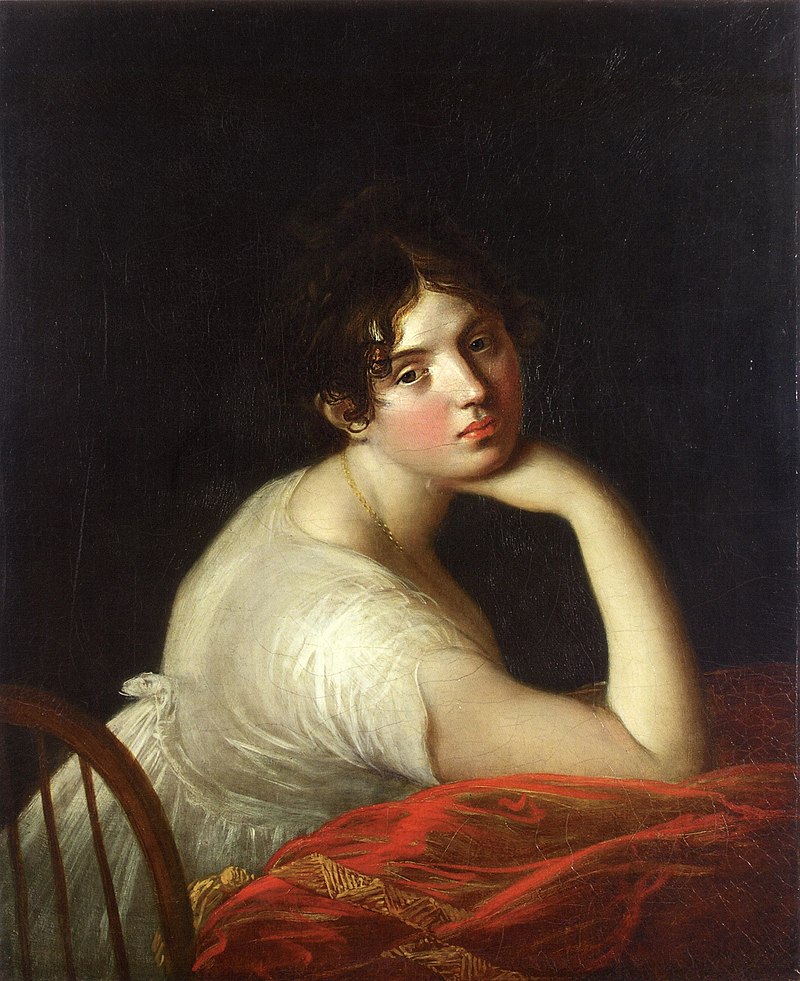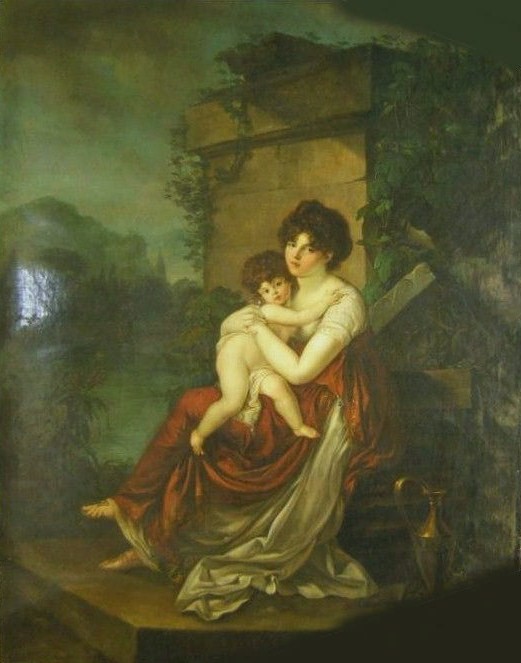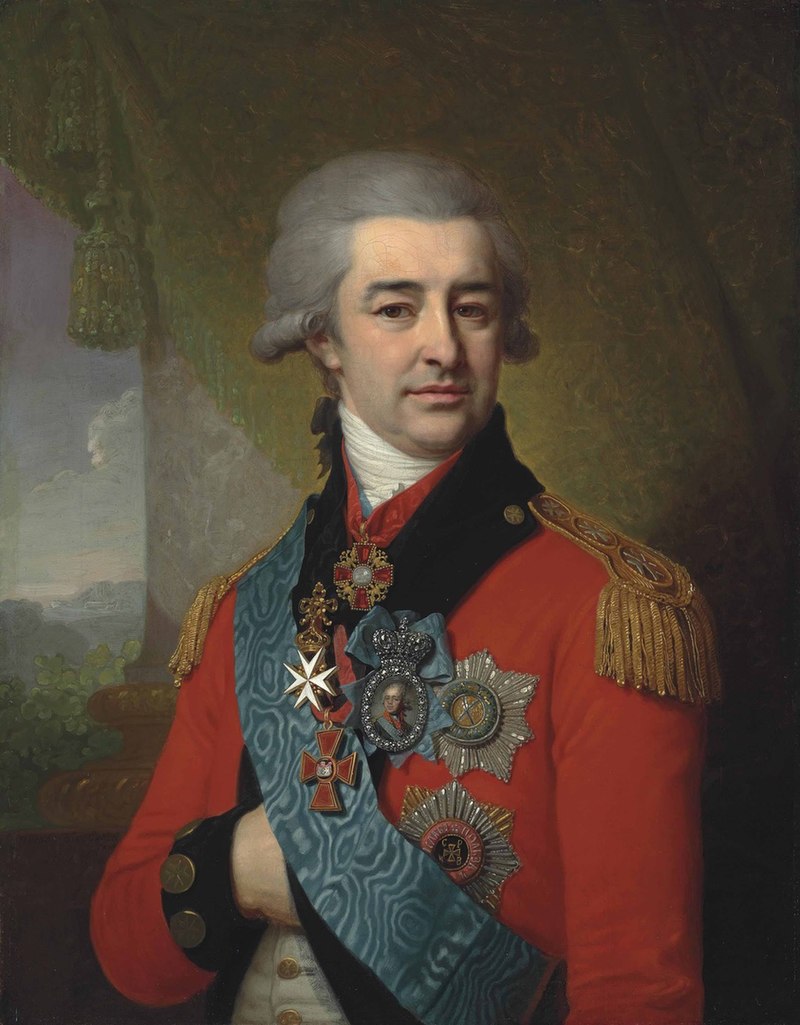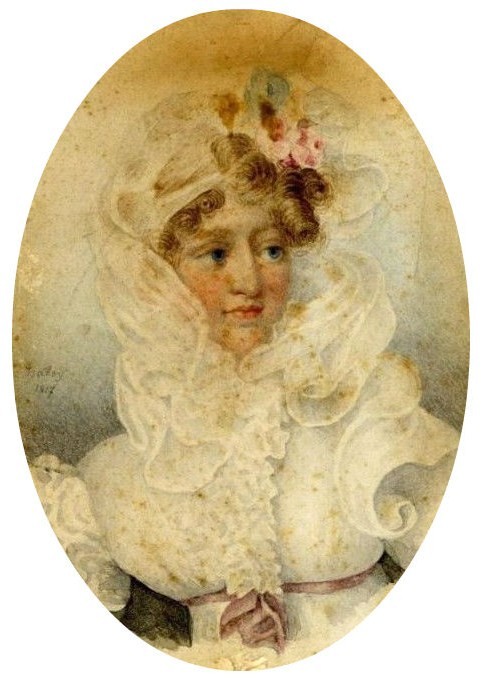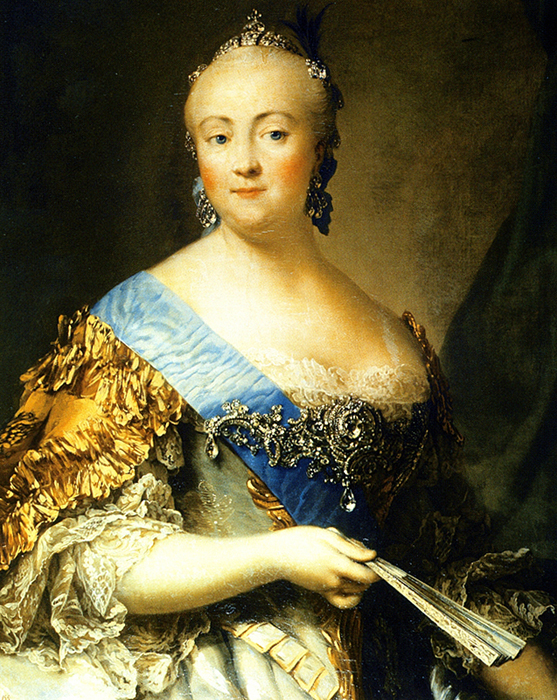by Susan Flantzer © Unofficial Royalty 2020

Count Grigory Grigoryevich Orlov; Credit – Wikipedia
Patronymics
- In Russian, a patronymic is the second name derived from the father’s first name: the suffix -vich means “son of” and the suffixes -eva, -evna, -ova, and -ovna mean “daughter of”.
Count Grigory Grigoryevich Orlov and his four brothers organized the coup d’etat that overthrew the husband of Catherine II the Great, Empress of All Russia, and gave her the throne of the Russian Empire.
Count Grigory Grigoryevich Orlov was the second of the five surviving sons of Grigory Ivanovich Orlov and Lukerya Ivanovna Zinovieva. He was born on October 17, 1734, at his father’s estate in the village of Lyutkino of the Bezhetsky Uyezd in the Tver Governorate in the European part of the Russian Empire. His father, Grigory Ivanovich Orlov, served in the Russian army and attained the rank of Major-General. After he retired from the army, Grigory Ivanovich was appointed Governor of Novgorod with the rank of State Councilor.
Grigory Grigoryevich had one older brother and four younger brothers. Collectively, they were known as the Orlov Brothers:
- Ivan Grigorievich Orlov (1733-1791), married Elizaveta Fyodorovna Rtishcheva, no children
- Alexei Grigorievich Orlov (1737-1808), married Evdokia Nikolaevna Lopukhina, had one son and one daughter
- Fedor Grigorievich Orlov (1741-1796), unmarried, had six illegitimate sons and two illegitimate daughters, later legitimized by Empress Catherine II
- Mikhail Grigorievich Orlov (born 1742), died in infancy
- Vladimir Grigorievich Orlov (1743-1831), married Elizaveta Ivanovna Stackelberg, had two sons and four daughters
Grigory Grigoryevich was raised in Moscow, where he was educated at home. In 1749, as a 15-year-old, he enlisted in the Semyonovsky Lifeguard Regiment. By 1757, he was an officer and took part in the Seven Years’ War. He refused to leave the battlefield at the Battle of Zorndorf after being wounded three times, which gained him much respect from his fellow soldiers. In 1759, he was transferred to St. Petersburg, where he joined the Preobrazhensky Regiment. Grigory’s transfer to the Preobrazhensky Regiment increased his popularity in St. Petersburg society. His good looks and physical qualities attracted the attention of Grand Duchess Ekaterina (Catherine) Alexeievna.

Grand Duchess Ekaterina (Catherine) Alexeievna, born Princess Sophie Auguste Friederike of Anhalt-Zerbst; Credit – Wikipedia
Grand Duchess Ekaterina (Catherine) Alexeievna, born Princess Sophie Auguste Friederike of Anhalt-Zerbst, was the wife of Grand Duke Peter Feodorovich (the future Peter III, Emperor of All Russia), the heir to the Russian throne. Peter’s maternal aunt, Elizabeth, Empress of All Russia, the daughter of Peter I (the Great), Emperor of All Russia, was unmarried. Peter had been born Prince Karl Peter Ulrich of Holstein-Gottorp, the son of Karl Friedrich, reigning Duke of Holstein-Gottorp and Grand Duchess Anna Petrovna of Russia, the elder of the two surviving daughters of Peter I (the Great), Emperor of All Russia. Peter’s mother died at the age of 20, three months after his birth. His father died when Peter was eleven years old and he became the reigning Duke of Holstein-Gottorp. Three years later, in 1742, Peter’s life dramatically changed when his unmarried maternal aunt, his mother’s younger sister, Elizabeth, Empress of All Russia, declared him her heir and brought him to St. Petersburg, Russia.
Peter and Catherine’s marriage was not happy, and both had lovers. In 1754, Catherine had given birth to a son, the future Paul I, Emperor of All Russia. However, it is quite possible that Paul’s father was not Peter but Catherine’s lover Sergei Saltykov. By 1759, Catherine and Grigory had become lovers, but no one told Catherine’s husband Peter. In the summer of 1761, Catherine became pregnant with Grigory’s child and concealed her pregnancy from her husband.

Grigory and Catherine’s son Alexei Grigoryevich Bobrinsky; Credit – Wikipedia
During Catherine’s pregnancy, Empress Elizabeth suffered a massive stroke and died on January 5, 1762. Her nephew, Catherine’s husband, became Peter III, Emperor of All Russia, and Catherine became the Empress Consort. Catherine gave birth to a son on April 22, 1762, at the Summer Palace in St. Petersburg. Immediately after the birth, the child, named Alexei Grigoryevich Bobrinsky was given to Catherine’s wardrobe master, Vasily Grigorievich Shkurin, to be raised with his family.

Catherine and Peter; Credit – Wikipedia
Peter was unpopular, and few were looking forward to his reign. After he became Emperor of All Russia, Peter did little to win the support of Empress Elizabeth’s friends and courtiers. His foreign policy also did little to win supporters. The last straw for Peter may have been how he treated the Russian army. Peter abolished “the guard within the guard”, a group within the Preobrazhensky Regiment, created by Empress Elizabeth as her personal guard in remembrance of their support in the coup that brought her to the throne. He replaced “the guard within the guard” with his own Holstein guard and often spoke about their superiority over the Russian army.
A conspiracy to overthrow Peter and place Catherine on the throne was planned and centered around the five Orlov brothers, with Grigory, Catherine’s lover, and Alexei being the main conspirators. On July 9, 1762 (June 29 in Old Style, the feast day of St. Peter and Paul), at Peterhof, a celebration on the occasion of Peter’s name day was planned. It was no coincidence that the conspirators chose this time for their attack. The day before, Peter was to travel from Oranienbaum to Peterhof. The brothers Alexei Orlov and Grigory Orlov made preparations during the weeks before the planned celebration. With threats and bribes of vodka and money, the Orlov brothers set up the guards against Peter.

Alexei and Grigory Orlov in the 1770s; Credit – Wikipedia
Peter was late leaving Oranienbaum due to a hangover and his daily habit of reviewing his Holstein troops. He was to meet Catherine at Peterhof, but she was not there when he arrived. Eventually, Peter and the few advisers he had with him began to suspect what was happening. Peter sent members of his entourage to St. Petersburg to find out what was happening, but none returned. He learned that Catherine had proclaimed herself Catherine II, Empress of All Russia, and that the senior government officials, the clergy, and all the Guards supported her.
Peter ordered his Holstein guards to take up defensive positions at Peterhof. They did so, but were afraid to tell Peter they had no cannonballs to fire. Peter thought about fleeing, but was told no horses were available because his entourage had all arrived in carriages. Learning that Catherine and the Guards were approaching Peterhof, Peter made a desperate decision to sail to Kronstadt, a fortress on an island. Upon arrival, Peter was refused admittance because all those in the fortress had sworn allegiance to Catherine. Peter rejected the advice of his advisors to go to the Prussian army and returned to Oranienbaum.
Peter and his Holstein guards were behind the gates at Oranienbaum when Alexei Orlov and his men surrounded Oranienbaum. Peter sent a message that he would renounce the throne if he, his mistress, and his favorite Russian general were allowed to go to Holstein. Catherine sent Grigori Orlov and a Russian general to Oranienbaum, insisting that Peter must write out a formal announcement of abdication in his own handwriting. Grigori Orlov was to deal with the abdication, and the general was to lure Peter out of Oranienbaum and back to Peterhof to prevent any bloodshed. Grigori Orlov rode back to Peterhof with the signed abdication announcement, and the general convinced Peter to go to Peterhof and beg Catherine for mercy. Upon arrival at Peterhof, Peter was arrested and taken by Alexei Orlov to Ropsha Palace, a country estate outside of St. Petersburg.
Catherine had to deal with the same dilemma that Empress Elizabeth had to deal with regarding Ivan VI who she had deposed – keeping a former emperor around was a threat to her throne. Catherine intended to send Peter to Shlisselburg Fortress, where Ivan VI, who had been deposed in 1741 as an infant, was still imprisoned. However, Catherine did not have to deal with a living deposed emperor for long.
One thing was certain – Peter was dead. He died at the age of 34 on July 17, 1762, at Ropsha Palace. What is uncertain is how he died. In the early afternoon of July 17, 1762, Peter was invited to dine with Alexei Orlov and Prince Feodor Baryatinsky, one of the officers of his guards. At 6:00 PM, a rider from Ropsha Palace reached St. Petersburg with a letter from Alexei Orlov for Catherine. Orlov wrote: “At dinner he [Peter] started quarreling and struggling with Prince Baryatinsky at the table. Before we could separate them, he was dead. We ourselves know not what we did. But we are equally guilty and deserve to die.”
Whether Peter’s death was planned or the result of an accidental drunken altercation is unknown. Catherine certainly benefited from Peter’s death, which happened in the presence of Grigory Orlov, one of her key allies, and his men. The Orlov brothers and the officers guarding Peter hated him. They would have known that they were doing the new empress a favor. The official cause of Peter’s death was “a severe attack of hemorrhoidal colic.”
On the day of Catherine II’s accession to the throne, Captain Grigory Orlov was promoted to Major General, given the title of Acting Chamberlain, and received the Order of St. Alexander Nevsky and a sword richly decorated with diamonds. On October 3, 1762, the day of Catherine’s coronation, Major General Grigory Grigoryevich Orlov was promoted to Lieutenant General and appointed Catherine’s Adjutant General. In addition, Grigori and all his brothers and their descendants were given the title of Count of the Russian Empire.

Gatchina Palace; Credit – By Usadboved – Own work, CC BY-SA 4.0, https://commons.wikimedia.org/w/index.php?curid=62884978
In 1765, Catherine purchased a small manor south of Saint Petersburg from Gatchina Manor and presented it to Grigory as gratitude for his role in the coup d’etat that brought Catherine to the throne. Catherine and Orlov commissioned a new palace to be designed by Antonio Rinaldi. Gatchina Palace was finally completed in 1781, almost 15 years after construction began, and Grigory died two years later in 1783. Catherine had taken a great liking to Gatchina Palace and bought it from Grigory’s heirs and presented it to her son, Grand Duke Paul Petrovich, the future Emperor Paul I. Thereafter, Gatchina Palace remained popular with the Russian Imperial Family.
Grigory never distinguished himself as a statesman but acted as a private adviser during the early years of Catherine’s reign. He was particularly interested in improving the conditions of serfs and their partial emancipation. Meanwhile, Orlov’s enemies, led by Nikita Panin, a statesman and political mentor to Catherine, attempted to break up the relationship between Orlov and Catherine. They informed Catherine that Grigory had been unfaithful to her. A handsome young officer, Alexander Vasilchikov, was installed as Catherine’s new lover, and Grigory was made to leave the court.

The Orlov Diamond in the Imperial Sceptre of Russia; Credit – Wikipedia
In an attempt to restore himself to Catherine’s affections, Grigory presented her with one of the greatest diamonds in the world, known ever since as the Orlov Diamond. Catherine accepted the magnificent diamond and had it encrusted into the Imperial Sceptre of Russia. However, when Grigory returned to court and went, without permission, to his Marble Palace in Saint Petersburg, Orlov found another favorite, the younger Grigory Potemkin, had replaced him. Lacking a role at court, Grigori went to Switzerland for several years. In 1777, at the age of 43, Grigory married his 18-year-old second cousin Catherine Zinovyeva, but they had no children. His young wife died of tuberculosis in 1781, at the age of 23, in Lausanne, Switzerland, where she was buried.

Orthodox Church of St. George Monastery, the burial site of Grigory Orlov; Credit – Par Mysquarehead — Travail personnel, CC BY-SA 4.0, https://commons.wikimedia.org/w/index.php?curid=43159066
Count Grigory Grigoryevich Orlov died at Neskuchnoe, his estate near Moscow, on April 24, 1783, at the age of 48. He was buried at the Orthodox Church of St. George Monastery (link in French) in Velikiy Novgorod, Russia. Grigory’s immense fortune was left to his son with Catherine, Count Alexei Grigoryevich Bobrinsky, who had been created a Count by his half-brother, Emperor Paul I.
In 1796, Catherine II (the Great), Empress of All Russia died, and her son succeeded to the throne as Paul I, Emperor of All Russia. As the Emperor of All Russia, Paul sought revenge for the deposed and disgraced Peter III and the coup d’etat of his mother, Catherine II and the Orlov brothers. On July 19, 1762, Peter had been buried without honors in the Alexander Nevsky Monastery in St. Petersburg. In 1796, immediately after the death of Catherine II, on the orders of her son and successor Paul I, Peter’s remains were transferred first to the Grand Church of the Winter Palace and then to the Peter and Paul Cathedral, the burial site of the Romanovs. 60-year-old Alexei Orlov was made to walk in the funeral cortege, holding the Imperial Crown as he walked in front of the coffin. Peter III was reburied in the Peter and Paul Cathedral in St. Petersburg at the same time as the burial of his wife Catherine II. Peter III had never been crowned, so at the time of his reburial, Paul I personally performed the ritual of coronation on the remains of his father’s remains.
This article is the intellectual property of Unofficial Royalty and is NOT TO BE COPIED, EDITED, OR POSTED IN ANY FORM ON ANOTHER WEBSITE under any circumstances. It is permissible to use a link that directs to Unofficial Royalty.
Works Cited
- En.wikipedia.org. 2020. Grigory Orlov. [online] Available at: <https://en.wikipedia.org/wiki/Grigory_Orlov> [Accessed 10 July 2020].
- Flantzer, Susan, 2018. Catherine II (The Great), Empress Of All Russia. [online] Unofficial Royalty. Available at: <https://www.unofficialroyalty.com/empress-catherine-ii-the-great-of-russia/> [Accessed 9 July 2020].
- Flantzer, Susan, 2018. Peter III, Emperor Of All Russia. [online] Unofficial Royalty. Available at: <https://www.unofficialroyalty.com/emperor-peter-iii-of-russia/> [Accessed 9 July 2020].
- Lincoln, W. Bruce. (1981). The Romanovs: Autocrats of All the Russias. New York, NY.: Doubleday
- Massie, Robert, (2016). Catherine the Great. London: Head of Zeus.
- Ru.wikipedia.org. 2020. Орлов, Григорий Григорьевич. [online] Available at: <https://ru.wikipedia.org/wiki/%D0%9E%D1%80%D0%BB%D0%BE%D0%B2,_%D0%93%D1%80%D0%B8%D0%B3%D0%BE%D1%80%D0%B8%D0%B9_%D0%93%D1%80%D0%B8%D0%B3%D0%BE%D1%80%D1%8C%D0%B5%D0%B2%D0%B8%D1%87> [Accessed 10 July 2020].

